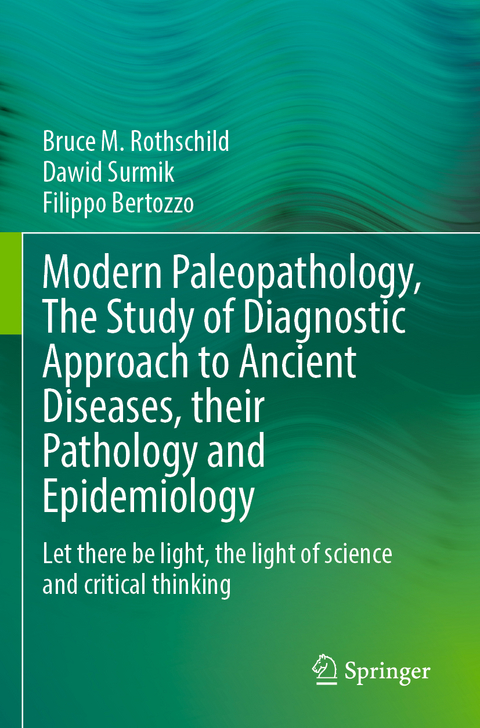
Modern Paleopathology, The Study of Diagnostic Approach to Ancient Diseases, their Pathology and Epidemiology
Springer International Publishing (Verlag)
978-3-031-28626-1 (ISBN)
What, beyond intellectual satisfaction, can the health care community expect from this relationship? The past history of the appearance and dispersal of infectious disease and cancer is of considerable theoretical importance and leads to new insights on the nature and transmission of diseases that are otherwise ambiguous. The discovery of rheumatoid arthritis in pre-Columbian North America exemplifies insights gained.
The current effort delineates osseous impact of disease (as manifest in clinical populations diagnosed in life), representation in the zoologic, paleontologic and anthropologic record, and assessment techniques that can be confidently applied. The chapters form "columns" that provide the foundation for scientific critical thinking. The actual integration of the information is in its application. Our purpose is to provide a data base and atlas of actually documented skeletal impact of diseases (as population phenomenon), an initial data base of reported skeletal pathology, and a methodology for expanding this to new arenas.
The first section of the book examines the scientific basis of paleopathology, its transition from speculation-based musings, resolution of misconceptions and the denouement of paleo-epidemiology. The second section provides holistic analysis of the gamut of pathology/diseases with significant skeletal impact, with a validated archeologic/zoological/paleontological record. The third section provides a glossary to resolve the semantic challenges inherent to interdisciplinary efforts. The fourth section provides an atlas of pathology representation in the fossil record. Ultimately, this book intends to present a scientifically-validated approach to recognition of disease in the archeological, zoological and paleontological record, superseding previous speculation-based offerings.
Bruce M. Rothschild graduated from New Jersey College of Medicine. He is a member of the Society of Vertebrate Paleontology, Fellow of the American College of Physicians, American College of Rheumatology and Society of Skeletal Radiology and elected to the International Skeletal Society. He has been recognized for his work in Clinical Rheumatology and Skeletal Pathology where his special interests focus on diagnosis, clinical-anatomic-radiologic correlation, data-based paleopathology, evolution of inflammatory arthritis and infectious disease and origins of disease. Dr. Rothschild is Professor of Medicine at IU Health and holds a Research Associateship at the Carnegie Museum.
He has been Professor of Medicine at Northeast Ohio Medical University in Rootstown, Ohio, Adjuvant Professor of Anthropology at the University of Kansas and of Biomedical Engineering at The University of Akron, Ohio and Research Associate at the Biodiversity Institute of the University of Kansas and the Carnegie Museum of Natural History. He was the first director of the Rheumatology Division at The Chicago Medical School and a prime force behind the resurgence of data-based paleorheumatology and comparative osseous pathology.
He has been a visiting Professor at universities in the US, Canada, the Caribbean, South America, Europe, the Middle East, South Africa, Asia and Australia and has been an invited lecturer at universities, hospital and museums throughout the world. He has published over 1000 papers and abstracts, including authoritative papers on bone maturation, the origins of rheumatoid arthritis, spondyloarthropathy, syphilis, tuberculosis, character of bone changes in metastatic cancer, myeloma, leukemia, tuberculosis, fungal disease, renal disease, treponemal disease, rheumatoid arthritis, spondyloarthropathy, gout, calcium pyrophosphate deposition disease, hypertrophic osteoarthropathy, primate bone disease and critical thinking not limited to paleopathology. He is the author of 7 books and has participated in 8 Discover Channel/BBC documentaries on origins of diseases and ancient reptiles.
Dawid Surmik graduated from the University of Silesia in Katowice, Poland, where he pursuedhis entire academic career from B.Sc. to a doctorate, and where he currently works as anassistant professor and researcher. He is a vertebrate paleontologist by education with specialinterests in evolutionary biology, paleoecology, and taphonomy. He became interested inpaleopathology in 2016 when he accidentally identified an intriguing bone alteration in the fossilmaterial he was studying. Then he started collaborating with Professor Bruce M. Rothschild,who was his mentor in the field, and with whom he began collaborating on subsequent projects. In 2019, he received financial support from National Science Centre, Poland for the researchproject ";Osteopathologies in the fossil record as a vector of paleoecological andpaleoepidemiological information," the frame in which he studied pathologies of Triassicmarine reptiles from Germanic Basin, terrestrial Triassic tetrapods from Krasiejów, Poland anddinosaur pathologies from Gobi Desert, Central Mongolia. Dawid believes that the prevalenceof diseases in animal populations sheds light on biosphere stress and is one of the most importantfactors influencing the survival of organisms in nature. Traces of diseases in the fossilmaterial provide a deep and multilevel understanding of the processes governing the evolutionof life on Earth. In particular, he thinks that examination of the occurrence of cancer in variousextinct animals will expand our knowledge of the evolutionary biology of ne
Part 1. Scientific basis for paleopathology.- Chapter 1: Philosophy of Science.- Chapter 2: Osseous structures and their response repertoire.- Chapter 3: Documentation of preservation.- Chapter 4: Postmortem alterations of bone (Diagenic Changes) and their interpretation.- Chapter 5: Misconceptions and false trails.- Chapter 6: Diagnostic approach/techniques.- Part 2. Holistic analysis of pathology/diseases with significant skeletal impact.- Chapter 7: Mechanically-derived phenomena.- Chapter 8: Inflammatory arthritis.- Chapter 9: Infectious disease.- Chapter 10: Hematologic.- Chapter 11: Metabolic/Endocrine.- Chapter 12: Vascular phenomena.- Chapter 13: Bone neoplasia and skeletal dysplasias.- Chapter 14: Cranial phenomena.- 15. Case Studies.
| Erscheinungsdatum | 10.09.2024 |
|---|---|
| Zusatzinfo | XXXVI, 851 p. 209 illus., 25 illus. in color. |
| Verlagsort | Cham |
| Sprache | englisch |
| Maße | 155 x 235 mm |
| Themenwelt | Naturwissenschaften ► Biologie ► Evolution |
| Schlagworte | Dinosaur • infectious disease • Metabolic disease • Osteoarthritis • paleoepidemiology • Paleopathology • Veterinary Medicine |
| ISBN-10 | 3-031-28626-X / 303128626X |
| ISBN-13 | 978-3-031-28626-1 / 9783031286261 |
| Zustand | Neuware |
| Informationen gemäß Produktsicherheitsverordnung (GPSR) | |
| Haben Sie eine Frage zum Produkt? |
aus dem Bereich


